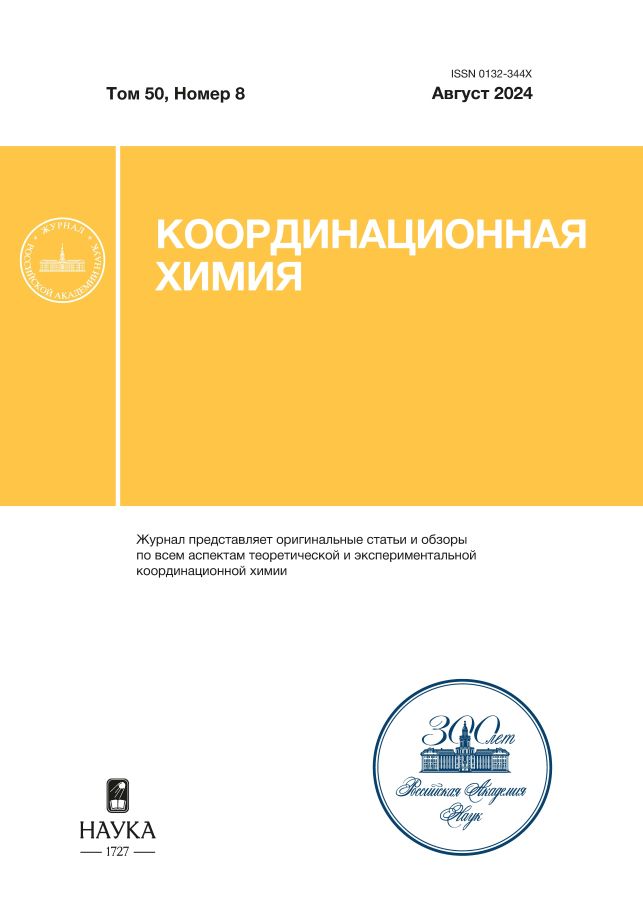The First Example of Dicubane Nickel(II) Complex in the Series of Unsymmetrically Substituted Diketones
- Authors: Khamidullina L.A.1,2, Puzyrev I.S.1, Dorovatovsky P.V.3, Khrustalev V.N.4,5, Pestov A.V.1,2
-
Affiliations:
- Postovsky Institute of Organic Synthesis, Ural Branch, Russian Academy of Sciences
- Ural Federal University named after the First President of Russia B.N. Yeltsin
- Kurchatov Institute
- Peoples' Friendship University of Russia
- Zelinsky Institute of Organic Chemistry, Russian Academy of Sciences
- Issue: Vol 50, No 8 (2024)
- Pages: 502-509
- Section: Articles
- URL: https://medjrf.com/0132-344X/article/view/667582
- DOI: https://doi.org/10.31857/S0132344X24080045
- EDN: https://elibrary.ru/MREYTE
- ID: 667582
Cite item
Abstract
The first homometal dicubane nickel(II) complex based on unsymmetrically substituted 1,3-diketone (1,1,1-trifluoro-4-(2-methoxyphenyl)butan-2,4-dione) was synthesized and studied by X-ray diffraction using synchrotron radiation (CCDC no. 861889). In the crystal of the complex, nickel atoms are joined into tetrahedra sharing a common vertex with Ni…Ni distances of 3.026–3.127 A; the geometry is completed to a distorted dicubane by μ3-bridging oxygen atoms of the hydroxyl groups. The coordination environment of each metal center is a distorted octahedron, the ligand is deprotonated and performs a bidentate function, forming six-membered chelate rings.
Keywords
Full Text
About the authors
L. A. Khamidullina
Postovsky Institute of Organic Synthesis, Ural Branch, Russian Academy of Sciences; Ural Federal University named after the First President of Russia B.N. Yeltsin
Email: puzyrev@ios.uran.ru
Russian Federation, Yekaterinburg; Yekaterinburg
I. S. Puzyrev
Postovsky Institute of Organic Synthesis, Ural Branch, Russian Academy of Sciences
Author for correspondence.
Email: puzyrev@ios.uran.ru
Russian Federation, Yekaterinburg
P. V. Dorovatovsky
Kurchatov Institute
Email: puzyrev@ios.uran.ru
Russian Federation, Moscow
V. N. Khrustalev
Peoples' Friendship University of Russia; Zelinsky Institute of Organic Chemistry, Russian Academy of Sciences
Email: puzyrev@ios.uran.ru
Russian Federation, Moscow; Moscow
A. V. Pestov
Postovsky Institute of Organic Synthesis, Ural Branch, Russian Academy of Sciences; Ural Federal University named after the First President of Russia B.N. Yeltsin
Email: puzyrev@ios.uran.ru
Russian Federation, Yekaterinburg; Yekaterinburg
References
- Shiga T., Newton G.N., Oshio H. // Dalton Trans. 2018. V. 47, № 22. P. 7384.
- Kirillov A.M., Kirillova M. V., Pombeiro A.J.L. // Coord. Chem. Rev. 2012. V. 256. № 23–24. P. 2741.
- Ungur L., Lin S.Y., Tang J. et al. // Chem. Soc. Rev. 2014. V. 43. № 20. P. 6894.
- Nesterov D.S., Nesterova O. V., Pombeiro A.J.L. // Coord. Chem. Rev. 2018. V. 355. P. 199.
- Wang K., Gao E. // Anticancer Agents Med. Chem. 2014. V. 14. № 1. P. 147.
- Muetterties E.L., Rhodin T.N., Band E. et al. // Chem. Rev. 1979. V. 79. № 2. P. 91.
- Zhao Q., Harris T.D., Betley T.A. // J. Am. Chem. Soc. 2011. V. 133. № 21. P. 8293.
- Sanz S., O´Connor H.M., Martí-Centelles V. et al. // Chem. Sci. 2017. V. 8. № 8. P. 5526.
- Horiuchi S., Tachibana Y., Yamashita M. et al. // Nat. Commun. 2015. V. 6. Art. 6742.
- Zaleski C.M., Tricard S., Depperman E.C., et al. // Inorg. Chem. 2011. V. 50. № 22. P. 11348.
- Engelhardt L.P., Muryn C.A., Pritchard R.G. et al. // Angew. Chem. Int. Ed. 2008. V. 47. № 5. P. 924.
- Schäfer B., Greisch J.F., Faus I. et al. // Angew. Chem.Int. Ed. 2016. V. 55. № 36. P. 10881.
- Shvachko Y.N., Starichenko D. V., Korolev A. V. et al. // Inorg. Chim. Acta. 2018. V. 483. P. 480.
- Murrie M., Stoeckli-Evans H., Güdel H.U. // Angew. Chem.. Int. Ed. 2001. V. 40, № 10. P. 1957.
- Aromí G., Parsons S., Wernsdorfer W. et al. // Chem. Commun. 2005. № 40. P. 5038.
- Keene T.D., Hursthouse M.B., Price D.J. // New. J. Chem. 2004. V. 32. № 9. P. 1.
- Petit S., Neugebauer P., Pilet G. et al. // Inorg. Chem. 2012. V. 51. № 12. P. 6645.
- Dong W.K., Zhu L.C., Dong Y.J. et al. // Polyhedron. 2016. V. 117. P. 148.
- Mameri S. // Inorg, Chim. Acta. 2017. V. 455. P. 231.
- Kuznetsova O. V., Fursova E.Y., Letyagin G.A. et al. // Russ. Chem. Bull. 2018. V. 67, № 7. P. 1202.
- Hameury S., Kayser L., Pattacini R. et al. // ChemPlusChem. 2015. V. 80 № 8. P. 1312.
- Khamidullina L.A., Puzyrev I.S., Glukhareva T. V. et al. // J. Mol. Struct. 2019. V. 1176. P. 515.
- Battye T.G.G., Kontogiannis L., Johnson O. et al. // Acta Crystallogr. D. 2011. V. 67, № 4. P. 271.
- Evans P. // Acta Crystallogr. D. 2006. V. 62. № 1. P. 72.
- Sheldrick G.M. // Acta Crystallogr. C. 2015. V. 71. P. 3.
Supplementary files


















